The concepts covered in this fact sheet go beyond those seen in high school. It is intended as a supplement for those who are curious to learn more.
Christianity is a monotheistic religion derived from Judaism.
Monotheism is faith in a single god, as opposed to the polytheistic worship of Roman mythology, which suggested the existence of several gods.
Christianity refers to all Christians and Christian countries.
Today, the Christian religion has taken on a mission with a universal vocation: to spread the teachings and faith of Jesus, the Son of God, recognized as the long-awaited Messiah whose coming was foretold in the sacred Hebrew texts.
The Christian faith is essentially based on the recognition of Jesus as the Son of God, the bearer of a universal message. In this religion, the one God is enshrined in a transcendent trinity: Father, Son and Holy Spirit. The resurrection of Jesus is also a key element of the Christian faith. Jesus' coming to earth, death, resurrection and ascension to heaven outline a message that heralds a new life in which salvation of the soul is possible through Jesus' sacrifice. Moreover, the crucifixion and resurrection are seen as proof that Jesus has reconciled mankind with God.
The values taught by Christianity are based on the testimonies of Jesus' life: love of neighbor and love of God, search for truth, resurrection, immortality of the soul, peace between men.
Two rites are more important than others in the Christian tradition: baptism and the Eucharist. Baptism serves to underline adherence to Christian values. The Eucharist recalls Jesus' last supper and is a symbolic invitation to share bread and wine.
Christianity was born during the Roman Empire. At that time, the Jews were under Roman domination and awaiting the coming of the Messiah who would liberate them and save their souls. The religious cult preached during this period gave the Roman emperor a central place, conferring on him the role of God's representative on earth. However, Rome was a conciliatory invader with regard to the respective traditions of the conquered peoples. Judaism was the only monotheistic religion in the Roman Empire. Despite this freedom of worship, the Jews were still subject to the laws, taxes and policies of the Roman administration.
According to historical records, Jesus was born around 4 B.C. and preached his messages between 27 and 30. Jesus' teachings were inspired by Jewish tradition. Moreover, in his speeches, he did not announce the creation of a new religion, but rather a reform of Judaism. Jesus' life as an itinerant preacher began with his baptism by Jean the Baptist. With his emphasis on God's wrath, he baptized the Jews to beg forgiveness.
Jesus, though inspired by the teachings of John the Baptist, announced God's judgment, emphasizing his love instead. He wished to reform Jewish tradition by bringing people closer to their God and desacralizing the institution. In addition to announcing the Kingdom of God, he promised eternal life through faith. Jesus' words, and the fact that he proclaimed himself to be the Son of God, aroused the wrath of the authorities, leading to his crucifixion around the year 30.
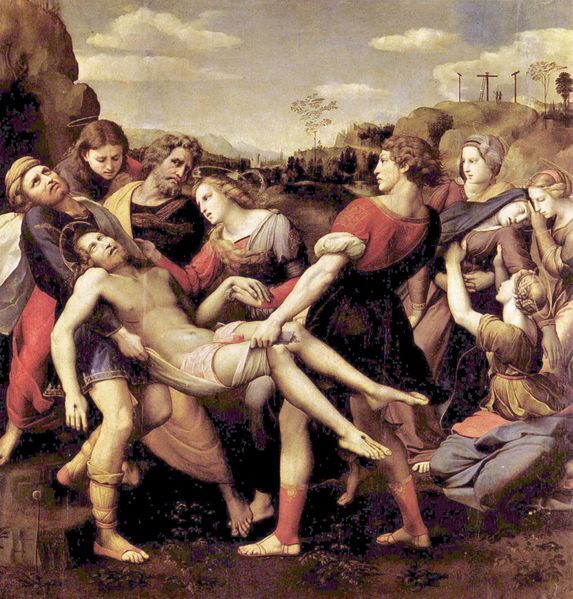
Christ taken from the cross, by Raphael
First formed after Jesus' death by the apostles and a small group of disciples, the first Christian community presented its new church as a new Judaism offering universal salvation. The disciples, having faith in their Messiah and his resurrection, wanted to share his message of love, but also to spread the Good News that he had been the long-awaited Messiah. The first converts to this faith were Jews who believed that Jesus really was the Messiah promised by the sacred texts.
The new followers of Christianity were divided into two groups: itinerant preachers who traveled to share Jesus' message, and sedentary sympathizers who shared the faith while maintaining their own way of life. Although their beliefs were no longer limited to the Old Testament, they continued to respect Jewish law.
As the number of new converts multiplied around the Mediterranean thanks to the Roman Empire's many roads, the Christian community gradually detached itself from its Jewish origins. Traveling missionaries also set out to convert non-Jews. The desire to convert is a characteristic of all monotheistic religions.
In addition to the separation between Jews and Christians, the Christian community is itself divided by different interpretations of faith, practices, worship, Jesus' message and so on. This is why Christians had to agree on certain dogmas at the Council of Jerusalem in the year 48. These meetings led Christians to the conclusion that conversion was necessary for the salvation of the soul.
The growing popularity of this new religion worried the Roman rulers and disturbed the Jews, who wished to remain faithful to their beliefs. Religious competition and the anxiety of rulers led to the first conflicts and persecutions of Christians. At the beginning of their history, Christians were exempt from emperor worship in the same way as Jews. However, persecution increased in parallel with the divisions of worship. Initially sporadic (1rst and 2nd centuries), they became increasingly systematic (3rd and 4th centuries ). Successive Roman emperors wished to suppress this sect, which was harmful to their empire. The many martyrs only served to fuel the Christian faith and increase Christian determination.
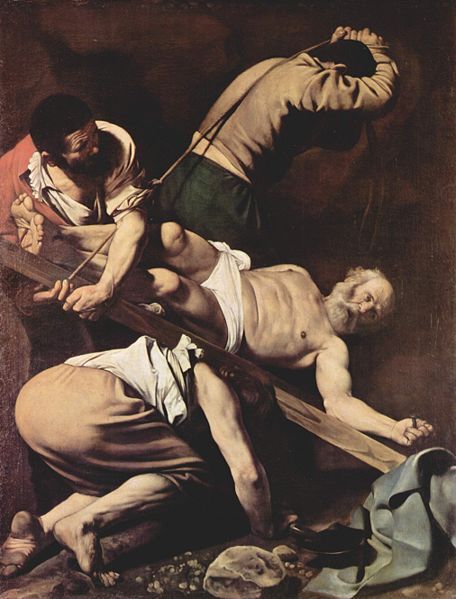
Crucifixion of the Apostle Pierre (Saint-Pierre)
In 313, with the Edict of Milan, Emperor Constantine recognized Christianity as the sole state religion. This announcement and the emperor's conversion put an end to persecution. In 356, pagan worship was banned.
Christianity was expanding from the shores of the Mediterranean to the entire continent of Europe. Many peoples converted or welcomed evangelizing missions. These included the Lombards in Italy, the Scandinavians and the Slavs. The term Catholic appeared as early as the 4th century, and means universal. The Catholic Church operates under a centralized hierarchy centered in Rome.
In the Catholic tradition, it is the Church that manages the salvation of souls through the teachings and graces it grants. Catholic worship involves the mass, seven sacraments necessary for salvation, and the worship of God, Jesus, Mary and the saints. The fall of the Roman Empire led, among other things, to the evolution of the Christian religion. Indeed, from 473 onwards, the Western and Eastern Churches evolved differently.
The Middle Ages saw the rise in popularity of Christianity thanks to the conversion of many peoples and kings. Crusades, cathedrals, monasteries and universities are all important reminders of the central place religion occupied during this period.
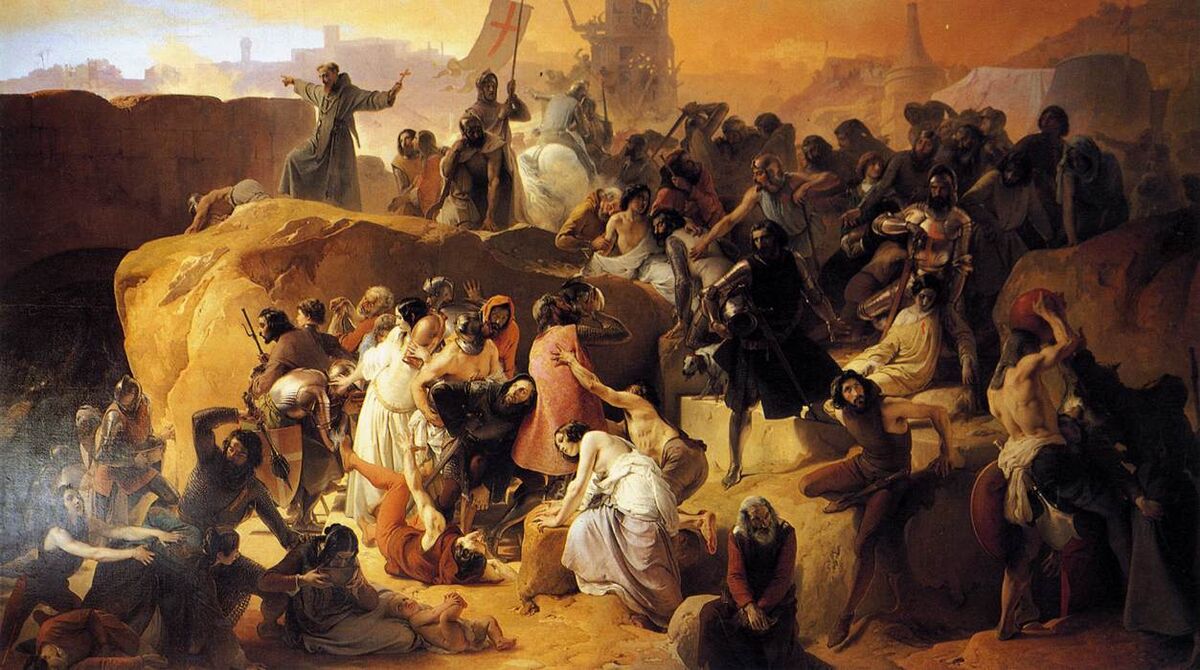
Crusaders take Jerusalem
The Christian religion was the cement of society, the source of morality and the protector of social order. It was from this era onwards that kings declared themselves to be God's representatives on earth, and enjoyed all powers.
A schism is defined as an ideological division within a group (such as the Church).
In 1054, differences between the Church of the East and the Church of the West broke out. The Church of Constantinople, located at the heart of the Byzantine Empire, refused to recognize the Pope as the heir to St. Peter's. This moment marked the detachment of the Eastern Church from the authority of Rome. This marked the detachment of the Eastern Church from the authority of Rome. The Orthodox Church, which grew out of this division, then spread to the Slavic and Balkan countries. Orthodox churches elect their own leaders. Their priests can marry and start families.
Over the centuries, various interpretations of the biblical message have emerged within the Christian community. Certain divergent ideas about the Trinity, the Resurrection and the divine nature of Jesus disturbed the Church, which branded these beliefs heretical. In the 13th century, the Church sought to confront and suppress the ever-growing heresies.
A heresy is a doctrine contrary to the teachings of a religion.
That's why the Church set up the Inquisition. The mission of this ecclesiastical institution was to seek out and suppress heretics. The Inquisition consisted of a religious tribunal backed by the civil authorities.
The tribunal of the Inquisition handled the accusations and judgments of those suspected of heresy. In fact, the Church left all powers to the inquisitors: indictment, prosecution, condemnation, incarceration and repression. The arrival of the Inquisition in a town aroused anxiety and fear, with threats of denunciation, interrogation and severe penalties. Punishments included physical punishment, torture, death sentences and imprisonment in harsh conditions.
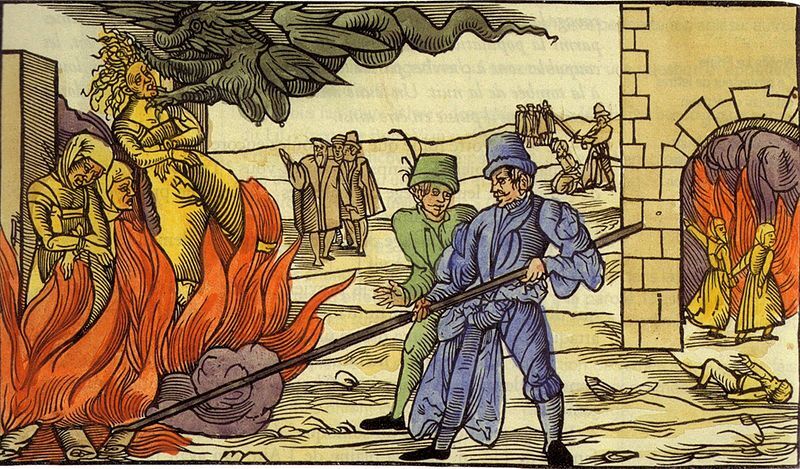
One of the worst punishments inflicted by the Inquisition was burning at the stake.
By the end of the 13th century, the Inquisition had gradually lost its power and influence. Strong repression and threats had silenced voices that didn't agree with the clergy's interpretation. In fact, the Inquisition aroused strong feelings of rejection and disgust. Although the Spanish Inquisition, run by Catholic kings and queens (such as Ferdinand and Isabella of Castile), lasted longer, most Inquisition tribunals gradually died out. In 2000, the power of the Catholic Church in Rome acknowledged its wrongdoing in this part of history.
Rome and the whole of Italy were greatly shaken by violence and popular unrest. It was against this backdrop that Pope Clement V, in 1309, decided to take up temporary residence in Avignon. This city in Provence was ideally situated for exercising pontifical power. However, this temporary installation lasted longer than expected. The popes built their palace and a chapel here. The Palais des Papes still stands in the city of Avignon.
In 1378, the Church was to elect a new pope. The Italians and Romans feared that the French would again elect a French pope to reside in Avignon. Their attitude during the debates ensured that it was an Italian who was elected pope, Urban VI. He settled in Rome, where he exercised a despotic and authoritarian power over the clergy and the populace. The cardinals, reacting to this situation, met to elect a new pope, Clement VII. He settled in Avignon.
The entire Christian community had to choose between two popes exercising different powers. The Great Western Schism divided Christendom into two groups. France, Scotland, Spain and southern Italy supported the Avignon pope, while England, the Holy Roman Empire and central and northern Italy supported the Roman pope.
Two popes held the same office simultaneously until 1418. After several attempts at reconciliation within the papacy and several official meetings, the agreements reached by the clergy at the Council of Constance put an end to the schism. Begun in 1414, the Council of Constance succeeded in electing a new pope, Martin V, who chose to establish the papal court in Rome. Since then, the pope's permanent seat has been in Rome.
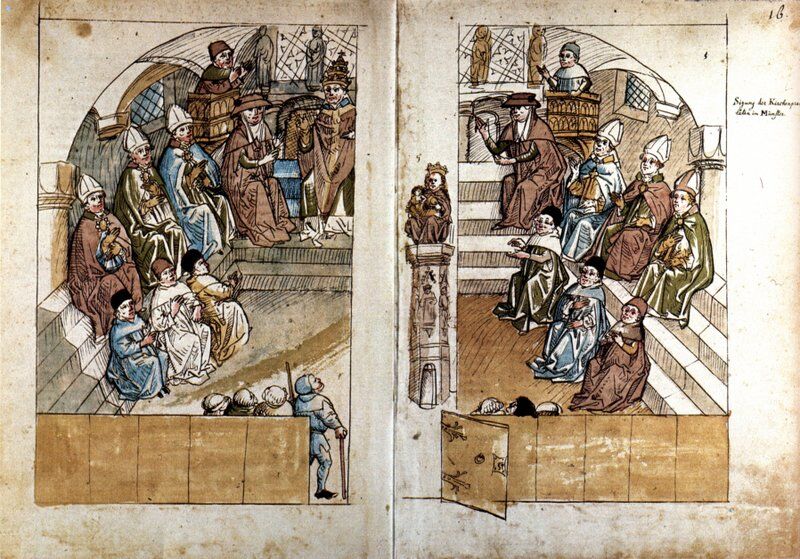
The Council of Constance
Even so, the Great Western Schism weakened the power of the Pope and the Church. It was after this crisis that intellectuals began to question certain aspects of religion, laying the foundations for the Reformation.
In the 16th century, a number of intellectuals began to criticize the decadence and abuses of the Church. The main reactionary writings were those of Martin Luther and John Calvin. Following the Church's refusal to change these practices, Luther's and Calvin's ideas gave rise to the Reformation.
The Catholic Church attempted a counter-Reformation in 1547. Its aim was to re-establish the supremacy of the Church of Rome over Christendom. The Reformation schism occurred in 1547, giving rise to numerous religious wars and the emergence of Protestantism.
Protestantism is the religion inspired by Luther and Calvin. A distinction is made between the Lutheran and Calvinist churches. The former developed predominantly in Germanic and Scandinavian countries, while the latter is concentrated in Switzerland, Scotland, the Netherlands and France.
The Protestant churches stood up against Rome's subservience and proposed new values such as freedom of conscience, the refusal of mediation in the administration of grace, and the adoption of common, democratic rules. Among Protestants, women are allowed to enter the ministry and pastors are allowed to marry. There is no strict hierarchy or clergy. Instead, Protestant pastors rely on the power of the word through preaching and the prioritization of two sacraments.
Later, in the 16th century, the schism continued when the Church of England also broke away from Rome to form the Anglican Church. The founder of this branch was Henry VIII, who wanted to send a message to the Pope that he would not accept his divorce being denied.
During the 17th and 18th centuries, philosophical currents became increasingly important, and intellectual figures were no longer linked to religion, but to philosophical currents. As a result, religious sentiment was diminished.
Thanks to this new thinking, human reason was no longer defined by the frameworks of religion. This new philosophy triggered a renewal of institutions.
This decline was even more marked during the French Revolution, when anti-clericalism reached new heights. It should be remembered that the revolutionaries were attacking the traditions associated with monarchy, and that kings legitimized their power by claiming to be God's representatives on earth. What's more, France's powerful clergy held a great deal of wealth and power. It was for this reason that a revolutionary period began against the clergy and the religious establishment. Church property was seized during the French Revolution and in the years that followed.
The century following the revolution was one of confrontation, not only between religions, but also between believers and atheists. In the 19th century, science became increasingly important. Religion was no longer sufficient to explain the universe, and even became an object of scientific study.
The term atheist refers to a person who does not believe in the existence of God, in the existence of a deity.
The 20th century was marked by a desire to unify the major Christian denominations, while respecting their different visions. This desire to facilitate dialogue between the different Christian churches is known as ecumenism. Several acts and treaties have resulted from this dialogue, in which the Catholic Church is an active participant, even though it objected to it for several decades. Moreover, the 20th century saw the secularization of institutions and the secularization of goods: Church goods were handed over to the public domain, and powers belonged to the public. Today, the Christian religion is in the majority in Europe and America. Catholics account for 60% of all Christians.
The sacred text of the Christian religion is the Bible. The Bible brings together all the texts and books recognized by Christians as being the Word of God. There are, however, differences between the Catholic and Protestant Bibles. The Bible is divided into two parts: the Old Testament and the New Testament. Today, it is the most widely distributed book in the world. The complete Bible has been translated into 310 languages, while the Old Testament has been translated into 695 languages. In 1972, the Bible benefited from an ecumenical translation, aimed at providing a common translation for both Catholic and Protestant churches.
The Old Testament originated in Judaism. It comprises 3 main sections: the Pentateuch, the Prophets and the Psalms. The Pentateuch comprises the first five books. All these books form a unity of meaning, since everything recounted in them is part of the story of the Promised Land and of Moses. The writing of this section is said to have taken around 800 years. The Prophets section brings together various prophecies. The Psalms are poems about faith and relationship with God. The other texts develop ideas around the art of leading one's life towards happiness: Job, Song of Songs, Ecclesiastes, Proverbs.
The aim of the entire New Testament is to pass on the teachings of Jesus by describing selected events and teaching them to Christians. In practical terms, the New Testament comprises 27 writings, including the Gospels, the letters of the apostles and Revelation. Each gospel (four in all) was written by an apostle. These texts are essentially based on the belief in the risen Jesus. The apostles who wrote the Gospels wanted Jesus to be recognized as the Messiah and the Son of God.
The four evangelists (Mathieu, Marc, Luc and Jean) recount much the same events: Jesus' life, teaching, death and resurrection. In fact, the apostles began writing the Gospels after Jesus' resurrection. The Gospels were part of their mission to teach the Good News. The texts thus helped to spread the Christian message. In addition to the Gospels, we also find letters, including those of Paul, which represent theological treatises on moral and Christian doctrine.
Many important intellectual figures have contributed to the development of Christian thought. While it is impossible to list them all, three intellectuals will be briefly introduced: Saint Augustin, Saint François d'Assise and Saint Thomas d'Aquin.
Saint Augustin developed the notion of original sin, according to which the sin committed by Adam and Eve falls on all humanity. In this vision of original sin, man is born in a state of sin, hence the importance of baptism in obtaining God's grace. According to Saint Augustine, there is no such thing as free will. In all cases, it is God who acts on man. Without God, man cannot decide to do good; he can only do good if he asks God for help and lets God guide him.

Saint Augustin
As a young man, Saint François d’Assise traveled extensively before being wounded in battle. By 1205, he had embarked on a life of charity, helping lepers and participating in the restoration of ruined churches. After committing himself to a life of poverty in the service of God, he formed the Franciscan order. Still in existence today, this order favors intellectual inquiry, enlightened contemplation, voluntary poverty and love of nature and life.
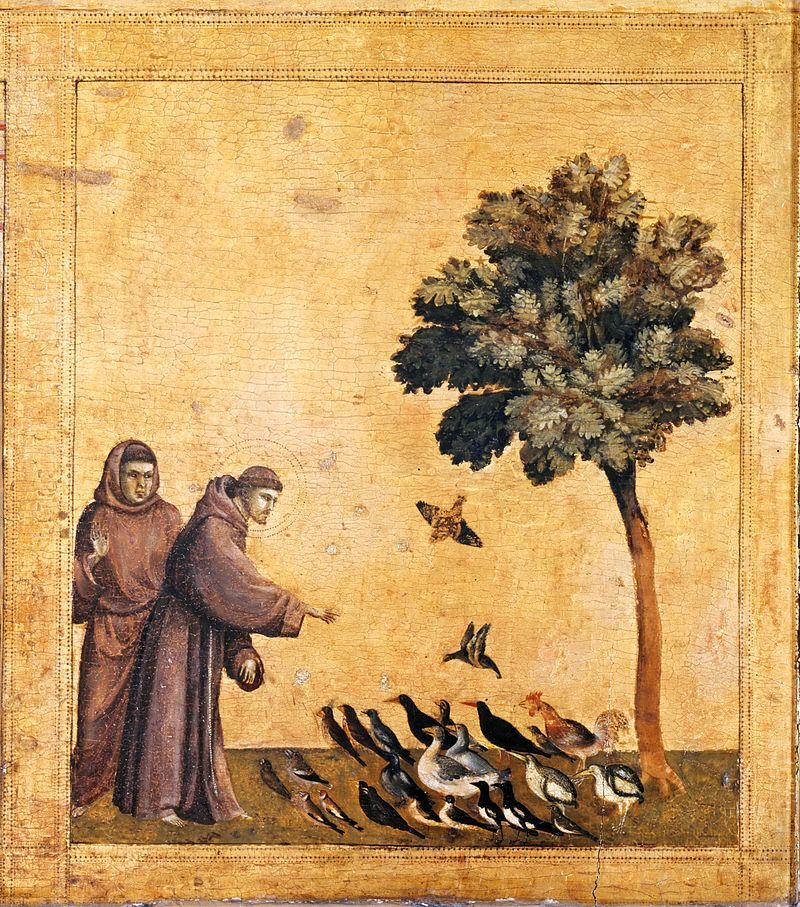
Saint François d'Assise
Saint Thomas d'Aquin was a theologian whose thought was strongly influenced by that of Saint Augustin and Aristotle. For him, faith consisted in adherence to the word of God and the conviction that reason was the natural light emanating from God and enlightening mankind. St. Thomas Aquinas' doctrine has three important aspects: God the Creator, human immortality and human freedom. In the 16th century, the thought of St. Thomas Aquinas became the official doctrine of the Catholic Church.
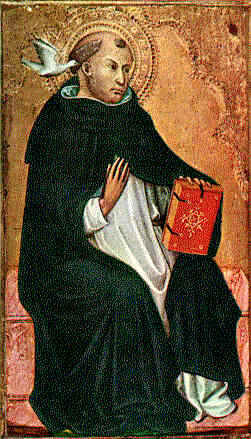
Saint Thomas d'Aquin